Average American sleeps 9.9 hours? I’d love to meet the guy who outweighs my 5-6 hours/night sleep for an average of 9.9
The French spend twice as much time eating as the Americans. Is that a surprise? 😉
Average American sleeps 9.9 hours? I’d love to meet the guy who outweighs my 5-6 hours/night sleep for an average of 9.9
The French spend twice as much time eating as the Americans. Is that a surprise? 😉
Great! Just great! Just when I thought I got the LWR fever down to a manageable level (though, I am looking forward to re-watching the series on my new plasma TV) and thought I won myself a year or two before I say “F*%@ it”, jump on the bike and take off searching for adventures on my sorry rear axle, somebody fz6 forum posts a link to “That I May Die Riding” by Oisin Hughes He writes about his 34,000-mile trip through Pan American Highway on a motorcycle. I started reading it and just cannot stop – I really like the guy and how he writes – lots of humor with some self-irony and great stories about his adventures.
Here is my idea for framework of mounts for Oregon Scientific ATC9K camera. Since I found original mounts somewhat flimsy, I decided to come up with my own version of mounts. The scematic shows three possible way to mount the camera – directly to mount, via tripod head (for angle adjustments), and surface mount.
Yesterday, after getting my Class 4 16Gb microSD card in the mail, I finally had a chance to test the battery life of the camera. My result is about 2 hours 50 minutes continuously shooting HD/30 video with GPS unit activated. During this time, my position was mostly stationary with clear view of the sky, so it’s possible that the battery would have been drained faster if GPS signal was interrupted from time to time. I periodically pressed the video button to bring the screen to life and see if it’s still recording (I’ve set the privacy mode to be my default – possibly another factor, though given how efficient LEDs are, I doubt it)
During the test, the camera wrote three video files – 2 files 3.8 Gb each and 1 file 2.7 Gb with the larger files being approximately 1 hour 04 minutes long and the smaller file being approximately 40 minutes long.
As I mentioned in the main review, I experienced an issue with a high-pitch noise appearing during the acceleration when mounted on the handlebar using the provided handlebar mount. Trying to alleviate the problem, I’ve replaced the rubber fitting that sits between the mount and the handlebar with special sorbothane, hoping that the vibrations would be absorbed. Unfortunately, the sorbothane fitting did not help – it “delays” the appearance of the noise, but does not eliminate it – so, the quest for mounting camera on the motorcycle continues.
Good camera, overall, many interesting features, that I hope will become more standard on other “action” cameras: snapshot ability, waterproof w/o any case, remote control, G-force sensor, and optional GPS unit. Not so good mounts (though, at least some of them), especially NOT motorsports-optimized, below average PC software UI. Above average video quality. Good controls. You will need to come up with some mounts yourself, but once you do, the camera performs great.
This past summer I played around with GoPro HD camera, and I liked it overall, but did not care for the controls, and having to switch backs back and forth. Controls of the camera are plain horrid! Do you really want me, the popcorn-chewing consumer, to have to memorize what those numbers mean? Anyways, back to store the camera went, and I thought to myself, “the ‘action’ cameras are still somewhat ‘raw'”. Fast forward 6 months, and I’m revisiting the camera question – I’d like to take some videos and pictures while riding, and I don’t want to mount Canon 7D onto the bike. After much research and thinking whether I should bite the bullet and go back to GoPro, I decided to give Oregon Scientific ATC9K camera a try. I got it from REI.com (20% off coupon and some dividends helped 😉 ) with the optional GPS module and after few days of waiting, here it is, in my hands.
The packaging looks impressive and promises video/photo paradise on earth. I like the black/yellow color scheme – very Monster Yamaha 🙂
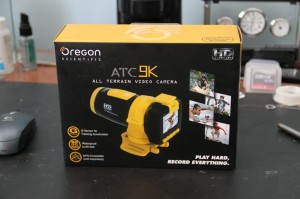 The package includes: camera itself, li-polymer battery, remote control, synthetic camera carry bag, helmet mount, handlebar mount, velcro and silicon straps, usb cable, front and rear protective caps, and hdmi cable. The required microSD Class 4 memory card is not included.
The package includes: camera itself, li-polymer battery, remote control, synthetic camera carry bag, helmet mount, handlebar mount, velcro and silicon straps, usb cable, front and rear protective caps, and hdmi cable. The required microSD Class 4 memory card is not included.
The controls are fairly simple and intuitive (watch and learn, GoPro!) there are two large buttons on top of the cylindrical body – one for taking a snapshot, and another one to start/stop the video recording. You cannot take a snapshot while making the video. The rear of the camera has 1.5 inch LCD screen (refer to the earlier comment, GoPro, no need to pay extra to get a “backpack” to be able to play the video) which I found sufficiently bright to view video on a sunny day. The screen contains all the needed information: shooting mode, exposure compensation, quality, photo quality, white balance, battery status and timer. There is also an optional leveling aid with longitudinal (roll) and lateral (pitch) indicators.
There are 5 control buttons under the screen: Menu, Previous, Play/Pause/Ok, Next, Power. These buttons are just the right size – I can even work them wearing summer motorcycle gloves – and they require some force to be pushed, so accidental activation is not likely.
One of the reasons why I got the camera is the remote control. It’s a nicely sized remote with buttons matching control buttons on the camera, minus the power button. The remote is NOT waterproof – something that I think Oregon Scientific could address – why not keep the “all-terrain” style in all working parts? Meanwhile, I’ll have to improvise: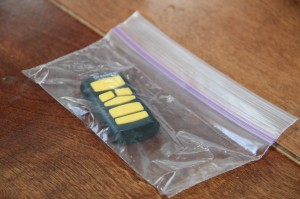
The remote seems to work at distances up to 10 ft., with one IR receiver only in the front of the camera.
Speaking of the front of the camera, here is the frontal view – the lens is set inside the plastic rim, so the camera can be put onto its front without damaging the lens. Right next to the lens, we have an LED indicator, laser pointer and IR receiver. The LED indicator shows charging status and recording status. The laser can be set to work for 5 or 10 seconds before the start of the video to align the shot.
Inside the waterproof door, we have the GPS module, the battery the microSD slot and HDMI and mini USB connectors (just when I hoped I could switch all my sync needs to microUSB, but Canon 7D uses mini as well, so I suppose i shouldn’t complain). The camera is waterproof to 60 ft./20 meters – not as diver-friendly as GoPro in its shell (down to 180 ft/60 meters), but the way I look at it, when you are at those depths, you have other things to worry about, such as pressure and light.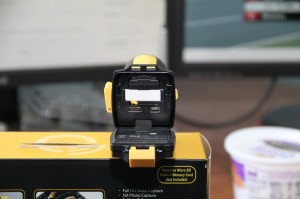
The only remaining external feature of the camera is the microphone which is located on the opposite side from the two main control buttons.
The camera powers up after the power button is pressed for more than 2 seconds and takes just about 2 seconds to power up. Luckily all the music can be disabled. Camera also has Privacy mode, where the camera will not make any sounds and will not indicate the recording status via the LED indicator.There are plenty of adjustments and modes to play with – on par with regular point’n’shoot cameras, which is pleasantly surprising, yet mostly useless, in my opinion.
One cool feature of the camera is the GPS module that is optionally available for the ATC9K camera. I am loving it – now I can record where I was without much thinking. The GPS module creates a .MAP file which is later read by Oregon Scientific software and plotted on Google Maps.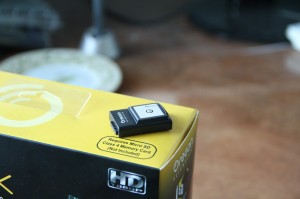
Another cool feature is the G-sensor which records the acceleration and velocity into the same .MAP file. The software that comes with the camera will display the information in parallel to the video as well as some statistics and charts, Acceleration plotted against time, for example.
Video:
The camera has 130 degree angle of view. Not as wide as GoPro’s 170 degrees, but good nevertheless.
There are few video modes available:
These settings can be permuted with Fine, Good and Normal quality levels.
Adjustments can be made to Exposure, White Balance, Contrast and Sharpness.
Duration can also be set to 15, 30 seconds, 1, 2, 5, 10 minutes to stop the recording.
Picture quality can be adjusted:
Resolution: 3 or 5 Megapixel
Quality: Fine, Good, Normal
Adjustments match those for the video mode, and there is a night mode available, which boosts exposure.
There are some neat features for taking pictures periodically: you can set 3 or 5 continuous shots with interval of 10, 20, 30 seconds and 1, 2, 5, and 10 minutes. There is also a timer for 5 or 3 seconds.
The microphone sensitivity can be adjusted between Maximum and Medium. No inputs for external microphones on this camera, but i’m guessing that’s the price of having a waterproof camera. Overall, the sound is good, however there is one problem I have noticed – when mounted on the handlebar of my Yamaha FZ6 using the included handlebar mount, there is an extremely loud high-pitch noise that appears during acceleration above 8-10 mph (warning: loud noise):
Originally, I suspected wind noise (some sort of a turbulence, given the location of the the mount vs location of the microphone, but I noticed an interesting thing – the noise goes away during the deceleration , even if the speeds are significantly higher than 8-10 mph threshold. I decided to see if the sound would be there if I mounted the camera elsewhere:
There is still strong wind noise, but the high-frequency sound is gone. Also, you can see how shaky the mount is.
After mounting the camera on my helmet, and NOT hearing the same noise, I can only conclude that the noise comes from the frame/mount combination. I sent a letter to Oregon Scientific Customer Service to see what they have to say. I am going to have to look into dampened camera mounts, I guess. Additionally, you can see that the narrow view angle does not work well with the handlebar mount.
As far as wind noise, I think it can be fixed with something along these lines: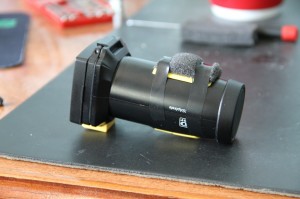
The software that comes with the camera causes mixed feelings. On one hand it’s an interesting piece combining the video window with Google Maps, and acceleration,speed, distance charts and averages. Really good idea, but poorly implemented from the UI standpoint. The main window cannot be resized, nor can the components be adjusted. What if i don’t want to see my library all the time, but want to see a bigger video instead? I’m out of luck. Also, try to find the button that downloads the content form the camera! It took me few minutes of clicking and listening to “Exclamation” sound (see below). Response is somewhat slow, and highlighting of the buttons (available vs unavailable) is inconsistent. Every time you press a mouse button, Exclamation sound plays. Cute, but becomes annoying after about 1 minute, especially if you are trying to re-play something, or clicking around trying to find the needed function. Not very well thought through interface, Oregon Scientific, AND it doesn’t run on systems other than Windows. Another feature I don’t get is the “login” feature – why should I log in, even though, as far as i can tell the videos and pictures are readily available in the Documents folder.
The mounts. I guess I got spoiled by GoPro “mount to anything” collection of mounting options. This camera is ok for a bicycle, perhaps, but the mounts are VERY flimsy.Here is how I mounted the camera onto the handlebar – this is the mount that caused the high-pitch noise.
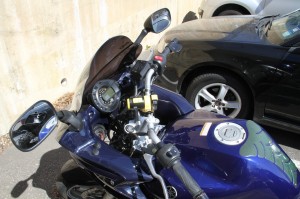
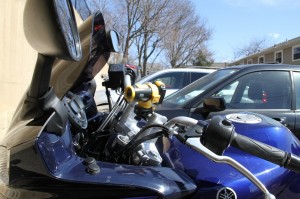 (note the latest nano-technology modification to ensure that camera stays still)
(note the latest nano-technology modification to ensure that camera stays still)
I wouldn’t take this camera/mount combination to a DH worrying the plastic would just snap. I remember mounting GoPro on the swingarm of my bike, for interesting video angle, and I will need to work out some sort of my own mount to do that with ATC9K.
Now, given the issue with the sound, I will have to look into dampened mounts, which will cost extra $$$. And I’m certainly NOT entrusting this piece of electronics to this little piece of plastic to hold my camera on my motorcycle:
In my dilettante opinion, this is a good camera for recording action, with some very useful features, such as waterproofing, remote control, integrated LCD, G-force recording, optional GPS unit. The video quality may not be the best, but it is at least very good compared to others. The sound is decent. The weak spot of this camera is the mounts that come with it – not enough of them and the ones that are there are not strong enough for hardcore applications. This camera would be great helmet camera for motorsports, DH biking, sky-diving, but the mounts are not up to par. Software gets another negative comment – it is something that looks like a good idea, but has confusing and not intuitive interface. Overall, I am keeping this camera, but will have to invest money and time into making my own mounts.
UPD1: Follow-Up #1
UPD2: Follow-Up #2
Day 2. Installing HID kit
As I mentioned before, I ordered a 4300K Blue Angel Eye HID kit from seller hot-bid88 on ebay. The kit took exactly 10 days to arrive. Here is the kit:
Found the kit at my doorstep after going out with friends, still a little buzzed, so decided to go right at it. By the time i was done with wiring it was 2 am.
Here is the cowling at the beginning of my night. I’d already mounted Stebel Nautilus horn on the left side. As you can see from the picture, Boneman’s Mods site is the essential guide. Big thanks, Boneman – I’d never think these things were even possible.
Here is the end result:
This kit has only one controller which I mounted on the right side, with relays for angel eyes mounted on velcros right under the headlight assembly. There is only one connector and I had to test the lights to figure out which one was which.
Fast forward few hours at my dad’s garage, and I got the cowling back onto the bike. Didn’t have much time left so didn’t take any pictures. Here are some from today though:
The original:
Now I just need to align the headlights and install the side panels in the cockpit. Almost done!!!!!
My MiG got itself Angel Eyes…
Random Thought of the day, as I sit on a presentation that has been going on for 2 hours:
Human attention span is about 15-20 minutes, and after that people will dose off. Plan your presentations accordingly.
http://www.ntlf.com/html/pi/9601/article1.htm
http://particletree.com/notebook/powerpoint-and-presentation-tips/
Day 1. Replacing the Cowling. Mounting Givi sidecase racks. Trying to Start
This is the goodies!!!!
Funny thing – I ended up with some “extras” in the box with the oem cowling I ordered – a whole bunch of gaskets, transmission parts (not from FZ-6, unfortunately) and some floor mats, that look like they belong to a scooter or, maybe, a waverunner.
Cowling
This is what the old cowling looked like:
While replacing it, I realized how badly bent the cowling bracket was at the point where the left mirror is mounted – i couldn’t even remove that mirror. I spent good 20 mins trying to shape it, and it will work for now, but i’m going to get a replacement.
Starting the Engine
I also tried to start the engine (I did not connect the battery to the tender when i put the bike into storage). Sure enough, the battery had only enough juice to display time. And my new YUASA charger wouldn’t recognize the battery. So what I did was take a regular 9V battery, made “jumper” wires and for a brief moment connected the 9V battery in parallel with the bike’s battery. My logic was that if the charger is “looking” for voltage, it should react to the spike caused by 9V battery. WARNING: Do NOT try to do this yourself after reading this post – I am known to try stupid things and take risks without really thinking what consequences could be – chances are, I just got lucky, because the charger switched into Charging mode.
Er-1 Code
After a few hours of charging, I tried to start the engine again, only to get the “Er-1” code. The fuel pump runs, the starter relay is ticking, and nothing. I brought ECU into house, and waited until the battery was charged, then replaced the ECU and voila, the bike started! Whether it was ECU or the battery, i am not sure.
Here is a short lapse-time video
Alllright, most of this white sh… s… stuff is gone, I’m almost ready to start the season.
I’m just as excited as i was last year when i rode my KLR in January.
After long, cold, sad winter that seemed like it would last forever, I’ve gone shopping for the new season. Yes, i got tax refund, as you can tell:
Something tells me i’ll spend considerable amount of time at my dad’s garage in the next few weeks. Can’t wait!!!!!